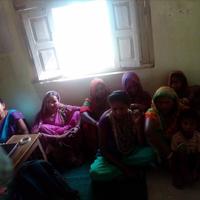
Research paints grim picture of domestic violence against women in Nepal’s lowlands
Nepal has one of the highest rates of domestic violence against women in the world as it is just emerging from its strong patriarchal past. Domestic violence or its fear prevents women from enjoying their rights and achieving their full potential in their professional, social and personal lives.
A recent research article published in Janaki Medical College Journal of Medical Sciences portrays a grim picture of domestic violence against women in a village of the Terai district Mahottari – 200 kilometres south-east of the Nepali capital Kathmandu. The research titled Study on domestic violence against women in Nepalese village of Terai Region, available online on the Nepal Journals Online platform, supported by INASP, has established strong links between education level and the vulnerability to domestic violence.
According to the research, less-educated women are more likely to be subjected to domestic violence than more highly-educated women. Among the 60 respondents who had been subjected to domestic violence, 20 (33.3%) were illiterate and 18 (30%) could barely read and write. Only 6.6% had a Bachelor’s degree.
The research, carried out by Shree Shyam Giri, Jitendra Kumar Singh, Radheshyam Giri, Lalan Kumar Jha and Sushil K Yadav, showed that alcohol abuse, a patriarchal mindset of the society, polygamy, sexual dissatisfaction and misunderstandings over dowry were the chief causes behind domestic violence against women.
“Violence occurs mainly due to low awareness level, poverty or unemployment in family members,” says lead author of the research article Shree Shyam Giri.
When people are unemployed they have fewer resources to meet their needs but more time to complain about it, he opines. “Although I conducted the research in a village of Mahottari district, it is a representative case of all villages in the Terai districts.”
The research article, shows that women suffer from mental and physical health problems, reproductive health problems and chronic conditions due to the domestic violence.
“It’s a big improvement compared to the past, but still we have to go a long way,” says Giri. “Compared to the past, the incidence of domestic violence has reduced, especially due to more awareness and employment opportunities.”
Giri says violence is more prevalent when young men stay at home unemployed. “Nowadays, as more people have started going abroad for employment and as they have started sending remittance back home, instances of domestic violence have reduced,” he adds.
However, according to Giri, the dowry system is nowhere near reform and continues to grow as one of the chief causes of domestic violence in Terai. Ironically, although increased access to education by women reduces their vulnerability to domestic violence, more educated men are likely to demand higher dowries and these are a major contributing factor in domestic violence.
“Unfortunately, the more educated people are becoming, the more dowry they are demanding instead of helping to abolish the system of dowry in Nepal,” he says. “So that way, education is also indirectly helping domestic violence.”
“Actually, there should be more focus on public awareness than on formal education only,” he says.
Dowry is an age-old tradition where the bride’s family offers gifts to the groom’s family in a wedding. The practice has become very negative these days as it has turned into a bargaining and negotiation for huge sums of money and expensive property that the groom’s family demands from the bride’s family to accept her as the bride.
“There should be more awareness and law enforcement should be stronger to control dowry-related violence,” says Mr Giri.
Failure to give the dowry demanded by the groom’s party often results in conflict between the two families, putting the newly-wed bride at the risk of violence from the in-laws. The severity of the violence is such that it has even resulted in death in many instances.
The research article Study on domestic violence against women in Nepalese village of Terai Region appears in the latest issue of Janaki Medical College Journal of Medical Sciences (2016) Vol. 4(1): 46-52 . It is available online on the NepJOL platform, which is supported by INASP and maintained by TUCL.
About the Journal
Janaki Medical College Journal of Medical Sciences is a peer-reviewed biannual journal published by Janaki Medical College. It covers research articles and review articles related to basic and clinical medical sciences, dental sciences, health issues, policies, medical education and related subjects for the benefit of medical and paramedical students, faculties, academicians, doctors, consultants, researchers, government officials and health policymakers.
About NepJOL
NepJOL hosts over 115 journals published from Nepal, covering the full range of academic disciplines. The objective of NepJOL is to give greater visibility to participating journals and to the research they convey. NepJOL was initiated in June 2006 and officially launched in September 2007. It is a project supported by INASP and locally managed by Tribhuvan University Central Library. It aims to promote the awareness and use of Nepal-published journals in all disciplines by providing access to tables of contents (TOCs), abstracts and full text on the internet.
About INASP
Founded in 1992, INASP is an international development organization working with a global network of partners in Africa, Latin America and Asia. In line with the vision of research and knowledge at the heart of development, INASP works to support individuals and institutions to produce, share and use research and knowledge, which can transform lives.
INASP’s approaches are based on the core pillars of capacity development, convening, influencing and working in partnership. INASP promotes equity by actively addressing the needs of both men and women across all our work and addressing issues of power within the research and knowledge system. INASP has projects in 28 countries, supporting all aspects of research and knowledge systems, from facilitating the provision of information to researchers to helping parliamentarians and civil servants to use research and evidence in policy making.
Disclaimer: Research published in journals hosted on the NepJOL platform is selected by the journals in accordance with their own editorial processes and criteria. INASP and Tribhuvan University Central Library provide hosting and guidance on good practices but are not involved in selection of research.
For further information
Thakur Amgai, Communications Consultant, INASP
Email: tamgai@inasp.info
Dr Sangita Shrestha, Communications Officer, INASP
Email: sshrestha@inasp.info

 Previous Post
Previous Post Next Post
Next Post


